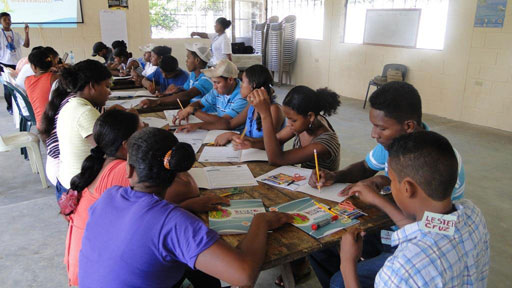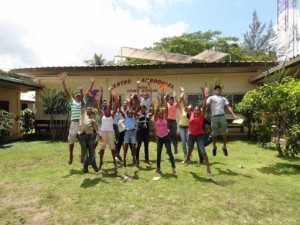[vc_row][vc_column width=”1/1″][vc_column_text]
HONDURAS:
AJR’s Grand Scheme Culminates in Municipal Crime Prevention Plans
[/vc_column_text][/vc_column][/vc_row][vc_row][vc_column width=”2/3″][vc_column_text]
Constructive engagement of youth – promises long-term gains for Honduras.
The totality of the human costs of violence is hard to quantify. But, trauma, loss of social capital and trust and extortion of local businesses have a crippling effect on basic political and economic development in any community. Since 1999, and despite the brokering of peace agreements, homicides have increased in El Salvador, Guatemala and Honduras making some of their cities among the most violent in the world.
In Honduras, about 42 percent of homicides committed are in the northern cities of San Pedro Sula, Choloma and La Ceiba where approximately 1.5 million people, or about 20 percent of the country’s population, reside. Homicides in these cities range from 158 homicides per 100,000 inhabitants in La Ceiba, to 80 in Choloma with sum total of homicides in the three cities accounting for over 25 percent of the national total.
More alarmingly, preliminary data for 2010 indicate that homicides in the three cities grew by 35 percent versus a national increase of about 20 percent. Do these grim statistics indicate that it’s too late to stop the violence? Is the fight lost? Not according to the Regional Youth Alliance USAID-SICA project which is planting seeds of hope for the worst off communities through launching a comprehensive strategy against violence in La Ceiba, Choloma and San Pedro Sula, reaching youth who are the primary perpetrators and victims of crime.
Beginning with the establishment of neighborhood Outreach Centers in 2008 that provide a safe space for youth to mingle, get assistance with homework, and access vocational courses, the AJR USAID-SICA project has structured these Centers to run on a shoe string budget with one staff person coordinating activities conducted by volunteers. Moreover, the Centers are supported by municipal governments, the private sector and religious institutions. Most recently, the Creative-implemented AJR USAID-SICA’s engagement to reduce violence has culminated in Municipal Crime Prevention Plans in Honduras’s three most violent cities.
“This is a collaborative effort on an issue that no single layer of government or sector is capable of solving and in which all, including civil society and the private sector have an important role to play,” said Salvador Stadthagen, Director for Honduras of the AJR USAID-SICA, project which is based in El Salvador where similar interventions are taking place.
At the core of AJR USAID-SICA’s philosophy is that preventive measures provide the greatest promise for curtailing violence and bridging the vast gap in guidance, structure, and goal setting that is so essential to youth. As such, the project’s holistic interventions range from establishing Outreach Centers to employment programs that involve the private sector, to youth movements against violence and to Municipal Prevention Plans that receive the support of municipal authorities.
AJR USAID-SICA activities have caught the imagination and participation not only of thousands of youth, but also the backing of ordinary citizens and of course municipal authorities who are now developing regulations that take account of the special needs of youth and women. Most impressive is that the project has also caught the attention of well known musicians who have given their time and talent to hold concerts and develop theme songs against violence that are now broadcast on the radio and TV.
The city of Choloma, known as Honduras’s industrial hub for its factories, is heavily impacted by the use and sale of drugs in neighborhoods with high unemployment, young people loitering in the streets, and sparse spaces for youth recreation. The conditions in Choloma were highlighted by the Violence Diagnostic conducted by the AJR USAID-SICA, providing a wakeup call that drove the city’s Municipal Crime Prevention Committee to conceptualize a Violence Prevention Plan bearing the slogan Choloma, Ciudad de Oportunidades, or Choloma City of Opportunities, that features vocational training, jobs, and sports for youth most vulnerable to violence.
 |
| Outreach Center beneficiaries celebrate better times. |
The launch Choloma’s Plan took place on February 9th on a hot afternoon. It was kicked off by the siren of the local fire department drawing 1,000 marchers and many more onlookers on its Caminata por la Vida de los Jóvenes Cholomeños or “Walk for Life with Youth from Choloma.” Making their way to Choloma’s city park down the boulevard on a march that covered ten city blocks, citizens carried banners and sang out slogans and quenched their thirst with drinks provided by a local beverage company. “Today the municipality of Choloma wants to show that you can prevent violence and to invite youth now, that we see Choloma as a City of Opportunities,” said the city’s Mayor, Leopoldo Crivelli, who took part in the events.
Following the march, a video was produced by young people themselves to communicate the essence of the non-violence campaign. A theme song “Choloma, what is happening to us?” was composed by 26-year old Darlan Mendoza head of an educational center who led the celebratory concert. “Thanks to programs like the Regional Youth Alliance USAID-SICA today we have an Outreach Center [here] in López Arellano and I can proudly say that I am from this community,” said Sindy Barahona, volunteer of the López Arellano Outreach Center and collaborator at the prevention plan launch.
While the momentum that AJR USAID-SICA has created in Honduras’s three most violent cities can be likened to an oasis in a desert, it is a beginning. Hope springs eternal, especially when harnessing the spirit and energy of youth and to enable them to develop goals, a sense of the future and most importantly civic duty.[/vc_column_text][/vc_column][vc_column width=”1/12″][/vc_column][vc_column width=”1/4″][vc_widget_sidebar sidebar_id=”sidebar-primary”][/vc_column][/vc_row]